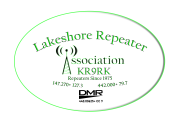Lakeshore Repeater Association Analog Systems information.
State of the Art is at the Heart of Lakeshore’s Analog Repeaters. Coverage for SE WI and NE IL
The Lakeshore Repeater Association’s 2 Meter KR9RK analog repeater on 147.270 MHz (+600 kHz) with CTCSS tone of 127.3 Hz and 70 centimeter KR9RK analog repeater on 442.000 MHz (+ 5.0 MHz) CTCSS 79.7 Hz is positioned on the border of Racine and Kenosha county’s for optimal performance. With its RX antenna at 465′ and TX antenna at 380′ our analog repeater systems provides reliable wide area coverage. State of the Art continuous Ham Duty Motorola SLR series repeaters have cutting edge technology DMR digital and analog modes for reliable 24/7/365 use with automated battery backup charging system with full online diagnostics. If you use this either of these machine’s and find it valuable we ask you consider supporting is costs by joining. The Lakeshore Repeater Association
KR9RK FM 2m and 70 cm repeaters
A Repeater makes long distance communications possible.
A repeater is an electronic device that receives a portables or mobile signal on one frequency and re-transmits the received voice audio at a higher output level on another frequency, so that the signal can cover longer distances without degradation. The term “repeater” originated with Morse code telegraphy and referred to an electro-mechanical device used to regenerate telegraph signals. Today the Lakeshore Repeater Association operate the Three KR9RK repeaters in the VHF and UHF spectrum including both analog and DMR UHF systems. These repeaters cover a large area of South Eastern Wisconsin and parts of North Eastern Illinois. These repeaters help the Ham Radio community keep in contact over long distances that would otherwise not be possible in the Very-High and Ultra-High Frequency spectrum.
Helpful repeater practices on Lakeshore Repeaters
Courteous and legal use of a repeater is the responsibility of every amateur radio operator. Amateur Radio Operators in an effort to promote Good Amateur Practice have established these guidelines to encourage good operating practices. Individuals who are unable abide by these guidelines may be asked to refrain from using the Lakeshore repeaters.
- Emergency use of a repeater always takes precedence over all other use.
- Organized activities such as nets or training drills have priority over routine conversations.
- Before keying your transmitter, listen for any activity on the repeater.
- Keep individual transmissions short. The timer on most repeaters is set to three minutes to follow FCC regulations. However, someone who talks for that long in one transmission may be using valuable time if someone else has an emergency.
- Please limit your continuous use of a repeater to a reasonable length.
- It is considered bad etiquette to interrupt an ongoing conversation unless you have an emergency or something meaningful to contribute to the conversation.
- Remember that in many areas, the proword BREAK is used for routine break-ins. When visitors or new users use it as such, very gently explain that the standard usage on this repeater is to reserve the proword “break” for things that are of more than routine urgency, but not true emergencies. An automobile accident with no injuries is a good example of a situation where the proword BREAK may be appropriate.
- While we want our repeaters to be active, it is discourteous to use a repeater to talk to someone who is within easy simplex range. If you can hear each other on the repeater input frequency, switch to a simplex frequency for that long-winded conversation.
- Our repeaters have a courtesy tone to indicate that the other party has released the key to end their transmission. Always wait for the courtesy tone so that someone with an emergency or someone wishing to join the conversation has ample opportunity to break in.
- You must identify your station with your callsign every ten minutes and at the end of a conversation. While the FCC rules no longer require that you identify at the beginning of a conversation, it is still good amateur practice and common courtesy to do so.
- Whenever you transmit, always identify your station, even if you just key up the repeater for a test purposes. “Kerchunking” (a short, unidentified transmission to “bring up the repeater”) is illegal and considered poor amateur practice.
- Keep your activities on our repeaters responsible and courteous. off-color remarks or comments have no place in amateur radio.
- The FCC rules permit the use of amateur radio for transmissions of a technical or personal nature. Unfortunately, some amateurs use the repeaters to discuss what they don’t like about the actions of another amateur or a particular group. Such comments have no place on a repeater. Keep them to yourself or take them off the air directly to the individual(s) involved.
- As in all of amateur radio, transmissions for business purposes is illegal. Please be especially mindful of this whenever using the repeater.
- If you frequent a repeater, you should support it. Repeaters require a considerable effort and money to maintain. Please support the Lakeshore Repeater Association. By joining the Lakeshore Repeater Association you will ensure this valuable resource will remain a part of our community
